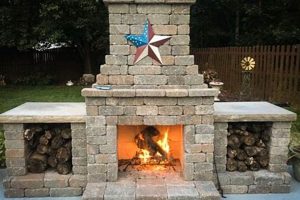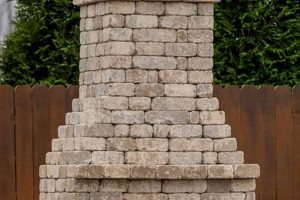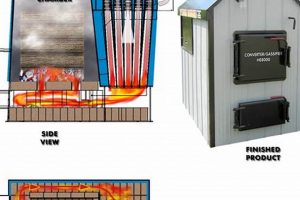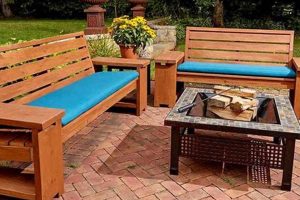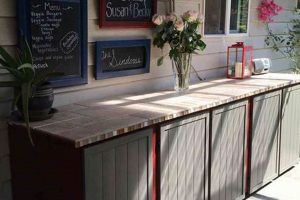A self-constructed heating system designed for exterior placement, utilizing wood as its primary fuel source to generate heat. This heat is typically transferred to a building via a fluid medium, such as water or antifreeze, circulated through underground pipes. This alternative heating method offers a user the ability to manage fuel costs directly by sourcing and processing firewood.
These systems can offer a significant reduction in reliance on conventional heating fuels like oil, natural gas, or electricity, potentially leading to long-term cost savings. Furthermore, the use of wood, a renewable resource, can be a more environmentally responsible choice when sourced sustainably. Historically, individuals have sought alternative heating solutions to achieve greater energy independence and manage heating expenses, particularly in regions with readily available wood resources.
The following sections will delve into the critical considerations for safe and effective design, construction, and operation, including material selection, safety precautions, regulatory compliance, and long-term maintenance aspects.
Essential Construction and Operational Considerations
The successful implementation of a self-built external wood-fueled heating unit requires meticulous planning and adherence to safety protocols. The following points outline crucial areas demanding attention.
Tip 1: Material Selection: Employ high-quality steel, designed for high-temperature applications, in the construction of the firebox and heat exchanger. Inadequate material selection may lead to premature failure and potentially hazardous conditions.
Tip 2: Welding Integrity: All welds must be performed by a certified welder to ensure structural integrity. Weak or porous welds can compromise the system’s pressure containment and overall lifespan.
Tip 3: Insulation Measures: Proper insulation of the firebox and water jacket is paramount to minimize heat loss and improve overall efficiency. Inadequate insulation leads to increased wood consumption and reduced heating capacity.
Tip 4: Safety Controls: Integrate multiple safety controls, including a high-temperature limit switch, a pressure relief valve, and a low-water cutoff, to prevent overheating and potential explosions. These controls provide essential safeguards against operational malfunctions.
Tip 5: Chimney Design: Ensure the chimney is of adequate height and diameter to facilitate proper draft and complete combustion. An improperly sized chimney can result in smoke backdraft and reduced heating efficiency.
Tip 6: Water Treatment: Implement a water treatment program to prevent corrosion and scale buildup within the system. Untreated water can severely diminish the lifespan and performance of the unit.
Tip 7: Regulatory Compliance: Verify all construction and operation adheres to local building codes, environmental regulations, and insurance requirements. Non-compliance may result in fines, legal action, or denial of insurance coverage.
Tip 8: Regular Inspection: Conduct frequent inspections of all components, including the firebox, water jacket, pumps, and controls, to identify and address potential issues before they escalate. Proactive maintenance extends the lifespan and ensures the safe operation of the system.
Careful attention to these points can significantly improve the functionality, safety, and longevity of a wood-fueled external heating unit, ensuring reliable and cost-effective performance for years to come.
The concluding section will provide a comprehensive summary of the essential considerations for the successful implementation of such a system.
1. Design Complexity
The intricacy of a self-constructed external wood-fueled heating system’s design profoundly influences its performance, safety, and longevity. Navigating this complexity requires a comprehensive understanding of thermodynamics, fluid mechanics, materials science, and safety engineering. The level of design sophistication directly correlates with the efficiency, reliability, and potential hazards associated with the apparatus.
- Heat Exchanger Configuration
The design of the heat exchanger determines the efficiency of heat transfer from the combustion chamber to the circulating fluid. Simple designs may involve a basic water jacket surrounding the firebox, while more complex designs incorporate intricate arrangements of tubes and baffles to maximize surface area and turbulent flow. Inefficient heat exchanger designs lead to wasted fuel and reduced heating capacity. Examples include parallel flow versus counter flow designs, each influencing heat transfer rates differently.
- Combustion Chamber Geometry
The shape and dimensions of the combustion chamber dictate the completeness of combustion and the reduction of emissions. A well-designed chamber promotes turbulence and uniform air distribution, ensuring efficient fuel burning and minimizing the formation of particulate matter and carbon monoxide. Poorly designed chambers may result in incomplete combustion, increased pollution, and reduced overall heating efficiency. Rectangular versus cylindrical chambers can affect airflow and combustion efficiency.
- Control System Integration
The complexity of the control system ranges from basic manual controls to sophisticated automated systems with sensors, actuators, and feedback loops. Advanced control systems can precisely regulate air intake, fuel feed, and water temperature, optimizing combustion efficiency and preventing overheating. Conversely, simplified systems require constant manual monitoring and adjustment, increasing the risk of operational errors and safety hazards. Programmable logic controllers (PLCs) are examples of advanced control components that can be integrated.
- Fluid Circulation System
The design of the fluid circulation system, including pump selection, pipe sizing, and expansion tank integration, determines the effectiveness of heat distribution throughout the connected structure. An improperly designed system can result in uneven heating, pump cavitation, and system overpressure. Factors such as pipe diameter, insulation levels, and pump capacity directly affect the system’s ability to efficiently transport heat to its intended destination.
These design elements illustrate the interconnectedness of various engineering principles required for a functional and reliable self-constructed heating apparatus. Simplified designs may compromise efficiency and safety, while overly complex designs can be challenging to construct and maintain. Striking a balance between functionality, constructability, and safety is paramount for the successful implementation of such a system, affecting parameters such as emissions and BTU (British Thermal Unit) output.
2. Welding Proficiency
The successful fabrication of a self-constructed external wood-fueled heating apparatus hinges critically on the competence of the welding performed. Substandard welding compromises structural integrity, leading to potentially catastrophic failures, reduced efficiency, and elevated safety risks. The quality of welds directly impacts the system’s pressure containment capabilities, resistance to thermal stress, and overall operational lifespan.
- Firebox Construction
The firebox, the core of the heating system, endures extreme temperatures and cyclical thermal stress. Properly executed welds are essential for maintaining the firebox’s structural integrity and preventing cracks or leaks. Inadequate welding can result in premature firebox failure, posing a significant safety hazard and necessitating costly repairs or complete system replacement. Examples of critical welds include those joining the firebox walls, the door frame, and any internal baffles or supports.
- Water Jacket Integrity
The water jacket, responsible for transferring heat from the firebox to the circulating fluid, must be completely leak-proof to prevent water loss and corrosion. Welding proficiency is paramount in ensuring the water jacket’s watertight seal and ability to withstand pressure. Poorly welded seams are prone to leaks, which can lead to reduced heating efficiency, system corrosion, and potential freezing damage. Seams connecting the water jacket panels and fittings are crucial areas for high-quality welding.
- Pressure Vessel Components
Many self-constructed systems incorporate pressure vessel components, such as expansion tanks or pressurized water jackets. These components necessitate welds that meet or exceed industry standards for pressure vessel fabrication. Deficient welding in pressure vessel components can lead to catastrophic failures, posing severe safety risks. Certified welders employing appropriate welding techniques and materials are essential for constructing safe and reliable pressure vessel components.
- Pipe Connections
The connections between the heating unit and the external piping system must be securely welded to prevent leaks and ensure efficient heat transfer. Welding proficiency is vital for creating strong, leak-proof joints that can withstand the pressure and temperature of the circulating fluid. Poorly welded pipe connections can result in heat loss, system corrosion, and potential water damage to surrounding structures. Careful attention to weld preparation, technique, and inspection is crucial for achieving reliable pipe connections.
The correlation between welding expertise and the success of a do-it-yourself external wood-burning heater is evident. Deficiencies in welding quality can lead to a spectrum of problems ranging from minor leaks and reduced efficiency to critical system failures and safety hazards. Engaging certified welders, employing appropriate welding procedures, and conducting thorough inspections are vital steps in ensuring the safe and reliable operation of a constructed heating unit. Strict adherence to welding best practices is a non-negotiable requirement.
3. Material Durability
The longevity and operational safety of a self-constructed external wood-fueled heating system are inextricably linked to the durability of the materials employed in its construction. Material selection dictates the unit’s ability to withstand the rigors of continuous high-temperature operation, exposure to the elements, and potential corrosion. Compromises in material quality invariably lead to premature failure, increased maintenance demands, and potential safety hazards.
- Firebox Steel Grade
The firebox endures the most extreme temperatures, often exceeding 1000F. The steel grade chosen for its construction must possess high tensile strength at elevated temperatures and exhibit resistance to oxidation and thermal fatigue. Common choices include A36 or A516 steel, but even these require adequate thickness (typically ” or greater) to ensure a prolonged lifespan. Lower-grade steels will warp, crack, and ultimately fail under these conditions, potentially releasing hot embers or flue gases. Industrial-grade boilers often utilize specialized alloys with superior heat resistance, albeit at a higher cost.
- Water Jacket Corrosion Resistance
The water jacket, responsible for transferring heat to the circulating fluid, is vulnerable to corrosion from untreated or improperly treated water. The selection of materials resistant to corrosion, such as stainless steel (304 or 316), or the implementation of robust water treatment protocols, is essential for maintaining the water jacket’s integrity. Galvanized steel offers a degree of protection but is susceptible to degradation over time. Corrosion can lead to leaks, reduced heating efficiency, and ultimately, water jacket failure. Regular water testing and treatment are paramount regardless of the material chosen.
- External Cladding Weather Resistance
The external cladding, which shields the internal components from the elements, must withstand exposure to rain, snow, sunlight, and extreme temperature fluctuations. Materials such as painted steel, aluminum, or durable composite panels are commonly used. The chosen material must resist rust, fading, and physical damage from impacts or abrasion. Deterioration of the external cladding can lead to insulation degradation, accelerated corrosion of internal components, and a reduction in overall system efficiency. Regular inspection and maintenance of the cladding are essential for preserving the system’s longevity.
- Insulation Material Degradation
The insulation surrounding the firebox and water jacket minimizes heat loss and improves overall efficiency. Insulation materials such as mineral wool, ceramic fiber blankets, or high-temperature fiberglass must retain their thermal properties and structural integrity over extended periods of exposure to high temperatures and moisture. Degradation of the insulation can lead to increased fuel consumption, reduced heating capacity, and elevated surface temperatures, potentially posing a burn hazard. Periodic inspection and replacement of degraded insulation are crucial for maintaining system performance and safety.
These examples highlight the critical influence of material selection on the performance and lifespan of a self-built outdoor wood-fueled heating unit. Each component demands materials specifically suited to its operating conditions, balancing cost-effectiveness with durability and safety. Compromising on material quality in any of these areas can significantly diminish the system’s overall value proposition and increase the risk of failure or hazardous conditions. Therefore, a meticulous assessment of material properties and careful selection are essential for a successful and long-lasting installation.
4. System Safety
The integration of robust safety mechanisms is not merely an optional addition but a fundamental prerequisite for any self-constructed external wood-fueled heating system. The inherent nature of these systems, involving high-temperature combustion and pressurized fluids, presents significant potential hazards. A lack of comprehensive safety features directly increases the risk of fire, explosion, carbon monoxide poisoning, and severe burns. The cause-and-effect relationship is straightforward: insufficient safety measures invariably lead to heightened risks of adverse events. The significance of system safety as an integral component cannot be overstated; it is the linchpin holding together the promise of cost-effective heating and the avoidance of catastrophic consequences. For instance, the absence of a high-temperature limit switch can allow the system to overheat, potentially causing a rupture of the water jacket and a steam explosion. The practical significance of understanding this connection lies in its direct impact on the well-being of individuals and the preservation of property.
Effective safety design incorporates multiple layers of protection, addressing various potential failure modes. A pressure relief valve serves as a crucial safeguard against over-pressurization, while a low-water cutoff prevents damage to the heating element in the event of water loss. A properly sized and installed chimney, combined with adequate ventilation, mitigates the risk of carbon monoxide buildup. Furthermore, adherence to established safety standards, such as those outlined by the National Fire Protection Association (NFPA), is essential for ensuring the system meets minimum safety requirements. These measures collectively reduce the probability of accidents and provide a degree of resilience in the face of unforeseen circumstances. Consider the example of a home where a properly installed carbon monoxide detector alerted residents to a malfunctioning heating system, preventing potentially fatal carbon monoxide poisoning.
In summary, the safety of a do-it-yourself external wood-burning heating system is paramount and intricately linked to its design, construction, and operation. Challenges in achieving adequate safety often stem from a lack of expertise, insufficient resources, or a failure to appreciate the inherent risks. Overcoming these challenges requires a commitment to thorough research, meticulous execution, and ongoing maintenance. The broader theme of responsible energy management underscores the importance of prioritizing safety above all else, ensuring that the pursuit of cost-effective heating does not come at the expense of human well-being and property protection.
5. Regulatory Adherence
The construction and operation of a self-built external wood-fueled heating system are subject to a complex web of regulations at the federal, state, and local levels. Strict adherence to these regulations is not merely a matter of legal compliance but a critical factor in ensuring the safety, environmental responsibility, and long-term viability of the system. Non-compliance can result in substantial fines, legal action, and the potential forced shutdown of the apparatus, negating any anticipated cost savings. Furthermore, operating outside regulatory frameworks can invalidate insurance coverage, leaving the owner financially vulnerable in the event of an accident or equipment failure. The ramifications of neglecting regulatory requirements are demonstrably severe and underscore the importance of due diligence.
Specific regulations governing these systems often address several key areas. These include emission standards, which dictate allowable levels of particulate matter and other pollutants released into the atmosphere. Building codes specify minimum safety standards for construction, including fire safety requirements and setback distances from structures. Zoning ordinances may restrict the location of outdoor burning appliances based on property size and proximity to neighboring residences. Additionally, water discharge regulations may govern the disposal of wastewater from the system, while electrical codes dictate safe wiring practices. A case study of a homeowner in rural Vermont revealed that failure to obtain the necessary permits for an outdoor wood boiler resulted in a $10,000 fine and required the removal of the unit. This example starkly illustrates the practical consequences of non-compliance. Jurisdictional regulations vary widely, necessitating thorough research before initiating any construction project. Obtaining the appropriate permits, consulting with local authorities, and conducting environmental impact assessments are crucial steps in ensuring compliance.
In summary, regulatory adherence is an indispensable component of a successful and sustainable self-built external wood-fueled heating installation. The intricate network of regulations at various levels of governance demands meticulous attention to detail. Challenges in navigating these regulations often stem from a lack of awareness or understanding, highlighting the need for thorough research and consultation with relevant authorities. Prioritizing compliance with all applicable regulations is paramount, ultimately safeguarding against legal repercussions, environmental harm, and potential safety hazards.
6. Maintenance Schedule
The operational effectiveness and longevity of a self-constructed external wood-fueled heating unit are directly proportional to the adherence to a well-defined maintenance schedule. Neglecting routine maintenance can lead to reduced efficiency, increased risk of component failure, and potentially hazardous operating conditions. A structured schedule provides a systematic framework for preventative measures, ensuring optimal performance and extending the system’s lifespan.
- Chimney Inspection and Cleaning
Creosote accumulation within the chimney is a significant fire hazard. Regular inspection, ideally monthly during peak usage, and cleaning, typically annually or bi-annually depending on wood type and usage frequency, are essential. Creosote buildup restricts airflow, reducing heating efficiency, and poses a substantial risk of chimney fires. Professional chimney sweeps possess the necessary tools and expertise to safely and effectively remove creosote deposits.
- Water Treatment Monitoring and Adjustment
Water quality within the system plays a critical role in preventing corrosion and scale buildup. Regular monitoring of pH levels, total dissolved solids (TDS), and the presence of inhibitors is necessary. Adjustments to the water treatment program, including the addition of corrosion inhibitors or anti-scale agents, should be made based on test results. Untreated or improperly treated water can lead to accelerated corrosion, reduced heat transfer efficiency, and eventual system failure.
- Component Inspection and Lubrication
Periodic inspection of all mechanical and electrical components, including pumps, fans, and controls, is crucial for identifying signs of wear or malfunction. Moving parts should be lubricated as needed to ensure smooth operation and prevent premature failure. Electrical connections should be inspected for corrosion or loose wiring. Neglecting these inspections can lead to unexpected breakdowns and costly repairs. Pumps often require annual lubrication and impeller inspection.
- Firebox Inspection and Repair
The firebox, subjected to extreme temperatures, is prone to wear and tear. Regular inspection for cracks, corrosion, or warping is essential. Minor repairs, such as patching cracks with high-temperature refractory cement, should be performed promptly to prevent further damage. Major repairs, such as replacing sections of the firebox, may require professional welding services. Ignoring firebox deterioration can lead to reduced efficiency, increased emissions, and potential safety hazards. The frequency of firebox inspections depends on the type of fuel burned and the intensity of usage.
These facets illustrate the multifaceted nature of maintaining a self-constructed external wood-fueled heating unit. Consistent adherence to a comprehensive maintenance schedule is not merely a suggestion but a fundamental requirement for ensuring the system operates safely, efficiently, and reliably over its intended lifespan. The benefits of proactive maintenance far outweigh the costs of neglect, contributing to long-term cost savings, reduced environmental impact, and enhanced safety.
7. Environmental Impact
The environmental implications of constructing and operating a self-built external wood-fueled heating system are multifaceted and demand careful consideration. These systems, while potentially offering economic benefits, introduce a range of environmental concerns that warrant meticulous evaluation and mitigation strategies. The impact spans air quality, resource management, and greenhouse gas emissions.
- Particulate Matter Emissions
The incomplete combustion of wood releases particulate matter (PM2.5 and PM10) into the atmosphere. These fine particles pose significant health risks, contributing to respiratory illnesses and cardiovascular problems. The design and operation of the system directly influence PM emissions. Inefficient combustion chambers and the use of unseasoned wood exacerbate the problem. Older, non-EPA-certified units often have substantially higher PM emissions compared to modern, regulated models. For instance, communities with widespread use of older wood stoves have experienced noticeable declines in air quality, particularly during winter months.
- Greenhouse Gas Emissions
Wood combustion releases carbon dioxide (CO2), a primary greenhouse gas. While wood is often considered a renewable resource, the net carbon impact depends on sustainable forest management practices. If harvested at a rate exceeding regrowth, or if deforestation occurs to supply fuel, the system contributes to increased atmospheric CO2 levels. Furthermore, the combustion process also releases methane (CH4) and nitrous oxide (N2O), which have significantly higher global warming potentials than CO2. A poorly maintained system with incomplete combustion will emit disproportionately higher levels of these potent greenhouse gases.
- Wood Resource Depletion and Deforestation
The sustainable harvesting of wood is crucial for minimizing the environmental footprint. Unsustainable logging practices can lead to deforestation, habitat loss, and soil erosion. The demand for wood fuel can incentivize illegal logging operations and contribute to the degradation of forest ecosystems. Responsible wood sourcing, including utilizing sustainably managed forests and promoting reforestation efforts, is essential for mitigating these impacts. Forest certification programs, such as those offered by the Forest Stewardship Council (FSC), provide assurance of sustainable harvesting practices.
- Impact on Local Ecosystems
The operation of a self-built system can indirectly affect local ecosystems. Smoke emissions can deposit pollutants onto vegetation and water bodies, potentially harming plant life and aquatic organisms. Ash disposal, if not managed properly, can contaminate soil and water. Furthermore, the noise generated by the system’s fans and pumps can disturb wildlife. Careful consideration of these indirect impacts is necessary to minimize ecological disruption. For example, locating the system away from sensitive habitats and implementing proper ash disposal methods can help reduce these effects.
The cumulative environmental consequences of these systems underscore the importance of responsible design, operation, and maintenance. Prioritizing high combustion efficiency, utilizing sustainable wood sources, and implementing effective emission control measures are essential for mitigating the negative impacts. A comprehensive environmental assessment should be conducted prior to construction to identify and address potential risks. Continuous monitoring of system performance and adherence to best practices are necessary for minimizing the long-term environmental footprint.
Frequently Asked Questions
This section addresses common inquiries regarding the construction and operation of self-built external wood-fueled heating systems. The information provided aims to clarify misconceptions and offer guidance based on best practices.
Question 1: Is it legal to construct and operate a self-built outdoor wood furnace?
Legality varies significantly depending on local, state, and federal regulations. Many jurisdictions have specific emission standards, setback requirements, and permitting processes that must be followed. Failure to comply can result in substantial fines and forced removal of the system. Thorough research of applicable regulations is essential before commencing any construction.
Question 2: What materials are suitable for building a firebox?
The firebox requires materials capable of withstanding extremely high temperatures and thermal stress. High-grade steel, such as A36 or A516, is commonly used. However, thickness is crucial; thinner gauges are prone to warping and failure. Refractory materials can also be incorporated to line the firebox and enhance heat retention.
Question 3: What safety measures are essential for a DIY outdoor wood furnace?
Multiple safety mechanisms are crucial. A pressure relief valve prevents over-pressurization. A high-temperature limit switch shuts down the system if overheating occurs. A low-water cutoff protects the heating element from damage if water levels drop. Regular inspection and maintenance of these safety devices are imperative.
Question 4: How can emissions be minimized from a self-built wood furnace?
Efficient combustion is key. Utilizing seasoned wood, ensuring adequate airflow, and employing a well-designed combustion chamber can reduce particulate matter emissions. Advanced designs may incorporate secondary combustion chambers or catalytic converters to further minimize pollutants.
Question 5: What type of maintenance is required for a wood burning furnace?
Regular maintenance includes chimney inspection and cleaning to remove creosote buildup, water treatment monitoring to prevent corrosion, and inspection of all mechanical and electrical components. The firebox should be inspected for cracks or damage and repaired as needed.
Question 6: Is a self-built system more cost-effective than a commercially available unit?
Cost-effectiveness depends on various factors, including material costs, labor expenses, and the system’s efficiency. While initial construction costs may be lower for a self-built system, long-term operating costs and potential maintenance expenses should be considered. Commercially available units often offer higher efficiency and may qualify for rebates or tax credits.
In summary, constructing and operating a self-built external wood-fueled heating system involves significant considerations related to legality, safety, environmental impact, and long-term maintenance. Thorough research and adherence to best practices are essential for success.
The next section will explore resources and further reading on the subject.
Conclusion
This exploration of diy outdoor wood burning furnace systems underscores the complexity and responsibility involved in their construction and operation. Key considerations include adherence to stringent safety protocols, meticulous material selection, and unwavering compliance with all applicable regulations. Environmental impact, particularly regarding emissions, demands careful mitigation strategies. A robust maintenance schedule is essential for sustained performance and longevity.
Potential adopters must carefully weigh the economic benefits against the significant demands of time, expertise, and regulatory navigation. Informed decision-making, guided by comprehensive research and professional consultation, is paramount. The responsible pursuit of alternative heating solutions necessitates prioritizing safety, environmental stewardship, and long-term sustainability above all else.



